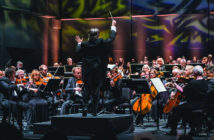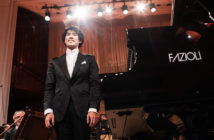This page is also available in / Cette page est également disponible en:
Français (French)
-
Analekta4
 “Darlings of the Muses.” Brahms: Symphony No. 1. Schumann: Symphony No. 1. Clara Schumann: Piano Concerto Op. 7. Gabriela Montero: Five Improvisations. Gabriela Montero, piano. National Arts Centre Orchestra/Alexander Shelley. Analekta AN 2 8877-8. Total Time: 122:17.
“Darlings of the Muses.” Brahms: Symphony No. 1. Schumann: Symphony No. 1. Clara Schumann: Piano Concerto Op. 7. Gabriela Montero: Five Improvisations. Gabriela Montero, piano. National Arts Centre Orchestra/Alexander Shelley. Analekta AN 2 8877-8. Total Time: 122:17.
Clara, Johannes and Robert (Schumann, Brahms and Schumann) have long been a source of voyeuristic fascination. In 1947 there was a sentimental movie, Song of Love, supposedly based on the triangle. Now there is Darlings of the Muses, a serious-minded album from the National Arts Centre Orchestra under Alexander Shelley combining orchestral music by all three with a set of improvised piano miniatures intended to probe into their shared spiritual space. Not many biographical dots are connected, but the two discs do assemble some highly listenable performances.
Clara Schumann’s Piano Concerto of 1835 should have a more prominent place in concert programming. The bold entry of the piano is surprising even on repeated hearings; the confidence with which themes are developed leaves the listener sorry that the first movement is so short. In the Romanze, the songful piano is joined by only a cello obbligato (warmly intoned by Rachel Mercer). The glittering finale (the first movement to be composed, and longer than the other two combined) suggests the influence of Chopin rather than Clara’s teacher Schumann (who might have had a hand in the orchestration). Brahms, born in 1833, obviously has nothing to do with this score, even if his Piano Concerto No. 2 coincidentally features a prominent cello solo in the slow movement.
Gabriela Montero plays with virtuoso panache or soliloquizing intimacy as the occasion demands. Anyone who has heard this Venezuelan in recital can testify to her remarkable powers as an improviser. Here we have five samples of her art in an appropriate 19th-century style, apparently based on original themes. The pieces scan as intermezzi for at-home listening, not public fantasies for the concert hall. The exquisite Improvisation No. 5, with a melancholy minor-mode coda, successfully invokes the spirits of Clara and Brahms. It would be interesting in future volumes (three more are foreseen) to hear Montero play Clara’s unpublished c. 1895 written-out improvisations, which are available online in manuscript form.
All is well in the orchestra as led by Shelley. Schumann’s Symphony No. 1 (“Spring”) is fleet and energetic. And sturdy: The triple-fortes of the first movement had me turning down the volume a notch. As good as this recording is, I find Yannick Nézet-Séguin’s 2014 DG version with the Chamber Orchestra of Europe (DG 479 2437) firmer-sounding as an audio artifact. In any case, neither conductor does much with the many forte/piano contrasts that Schumann requires (as in the cantabile cello tune of the Larghetto). Brahms’s First starts too quickly. Once we reach the Allegro, however, the sailing is clear. The Andante sostenuto brings us close to the composer at his most tender. Solos are sweet and the pace is natural. The third movement is relaxed – almost a minute slower than historically-minded Charles Mackerras and the Scottish Chamber Orchestra – and strings in the finale (reinforced by subs, to judge by the list of musicians in the Analekta booklet) have the requisite breadth. Two more requests for future issues: Schumann’s Symphony in G Minor (“Zwikau”) and Clara’s (likewise unfinished) Konzertsatz in F Minor. We have quite a few recordings of the standards!
This page is also available in / Cette page est également disponible en:
Français (French)















